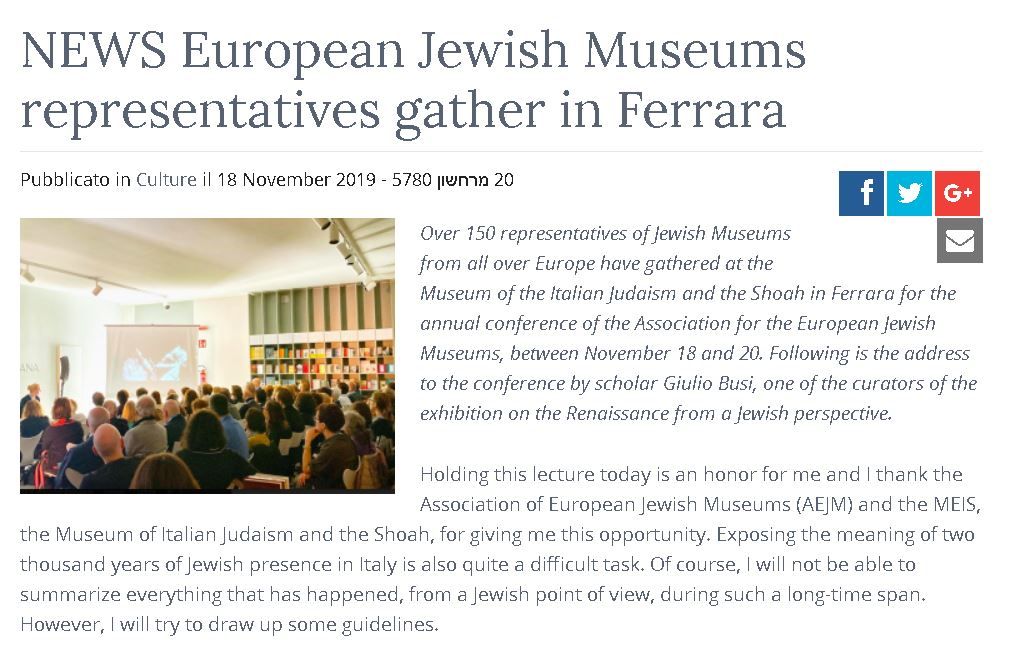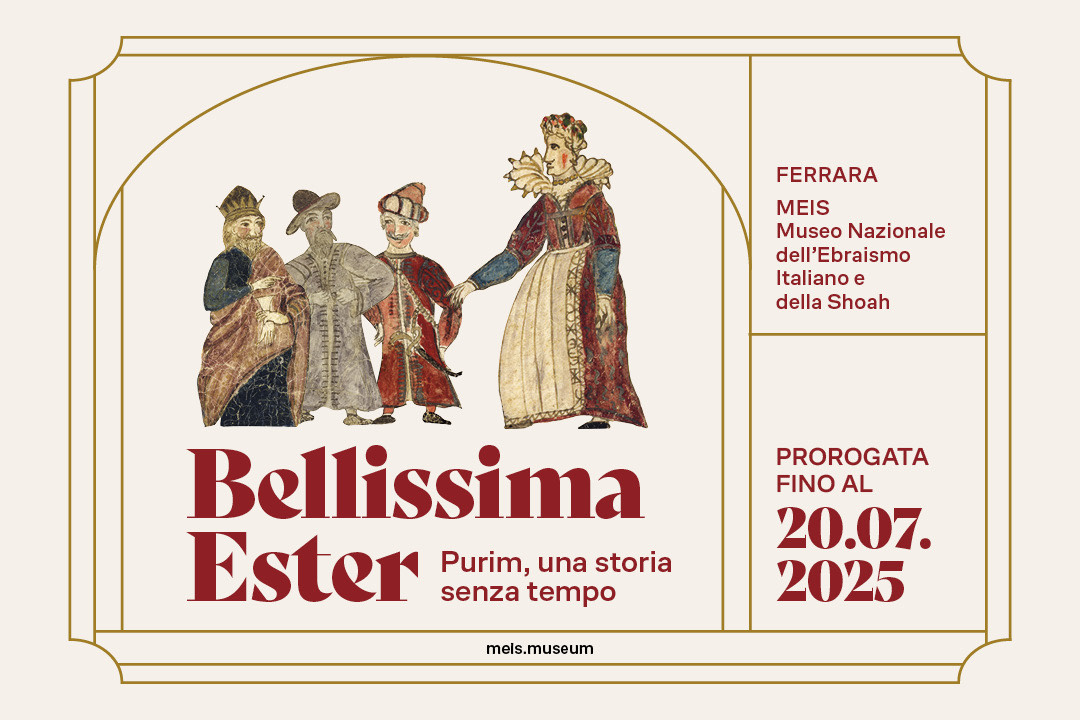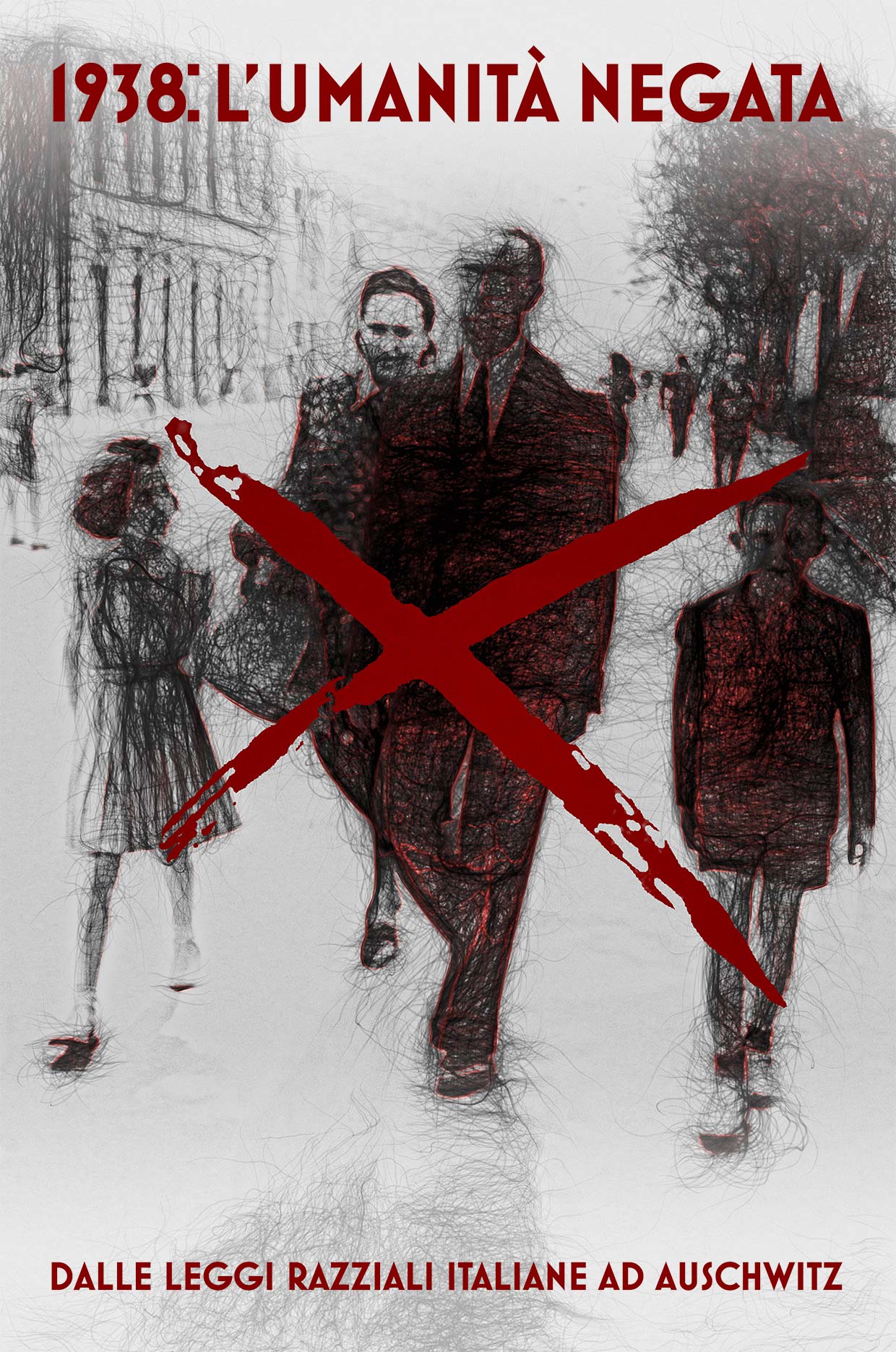
European Jewish Museums representatives gather in Ferrara

Over 150 representatives of Jewish Museums from all over Europe have gathered at the Museum of the Italian Judaism and the Shoah in Ferrara for the annual conference of the Association for the European Jewish Museums, between November 18 and 20. Following is the address to the conference by scholar Giulio Busi, one of the curators of the exhibition on the Renaissance from a Jewish perspective.
Holding this lecture today is an honor for me and I thank the Association of European Jewish Museums (AEJM) and the MEIS, the Museum of Italian Judaism and the Shoah, for giving me this opportunity. Exposing the meaning of two thousand years of Jewish presence in Italy is also quite a difficult task. Of course, I will not be able to summarize everything that has happened, from a Jewish point of view, during such a long-time span. However, I will try to draw up some guidelines.
As we are guests of a city like Ferrara, which is also a jewel of Renaissance culture, I will try to draw, in the Renaissance spirit, a perspective of the longue durée of Italian Judaism. There is no doubt that the focal point of such a perspective is Rome. This is in fact the place where Jews have always been present, from ancient to contemporary times. While elsewhere their presence has experienced long periods of interruption, or at least is not attested by the sources for even considerable periods, Rome has never ceased to host a Jewish community. In some phases, it was a rather substantial nucleus, while in other periods it was a few dozen individuals. As if it were the ner tamid of Italian Judaism, the Jewish light of Rome has always remained alive and vital. An article, just published in the November issue of “Science” magazine, shed new light on the first steps in the history of Rome. It is a genetic survey, which involved experts from many universities around the world and presents 127 genomes from 29 archaeological sites in and around Rome, spanning the past 12,000 years. We observe two major prehistoric ancestry transitions: one with the introduction of farming and another prior to the Iron Age. By the founding of Rome, the genetic composition of the region approximated that of modern Mediterranean populations.
During the Imperial period, Rome’s population received net immigration from the Near East, followed by an increase in genetic contributions from Europe. These ancestry shifts mirrored the geopolitical affiliations of Rome and were accompanied by marked interindividual diversity, reflecting gene flow from across the Mediterranean, Europe, and North Africa. In particular, two thirds of Imperial individuals (31 out of 48) belong to two major clusters that is central and eastern Mediterranean populations, such as those from southern and central Italy, Greece, Cyprus, Lebanon, Syria and of course Israel. This latest research of “Science” brings important results.
In the Imperial age, Rome had a population with a very strong component from the eastern Mediterranean. In the fourth century, with the displacement of the capital of the empire to Constantinople, this component almost disappeared, with one exception: the Jews. I spoke of a perspective that allows us to understand Jewish history in the Italian peninsula. The perspective is this: Jews are an ancient, original and tenacious part of the history of this country. They are not temporary immigrants, but they belong to the older nucleus. You don’t understand Italy, and not only the Jewish one, if you don’t look at its position in the Mediterranean and its 7600 kilometers of coastline. This has always been a land open to the sea and has always included one wave of immigration after another. In the variation of these migrations, Jews have constituted an element of continuity, a true backbone of the society and culture of the Peninsula. Italy it has always been a country of diasporas: from the eastern Mediterranean, from northern Europe, from western Europe.
In turn, Italy has been one of the fulcrums of the Jewish diaspora. In ancient times, one of these centers was the port of Ostia, which still has the magnificent remains of the synagogue, the oldest yet uncovered outside Erez Israel. And you see here David Roberts’ Destruction of Jerusalem in 70. Rome and Jerusalem are inextricably linked: in the imagination, in history, in architecture, in urban planning. This is the world-famous Arch of Titus, depicting the spoils taken from the Temple in Jerusalem, with the golden Menorah as the main focus, carved in deep relief. Jerusalem penetrates the stones and monuments of Rome, just as Rome wedges itself into the historical memory and symbolism of Jerusalem. It does not matter if they are very often memories of clashes, revolts, destruction. Alongside this negative part – there is the very long interweaving of coexistence, of mutual interest, of economic interaction. Something similar has happened during all the immigration, conquests, invasions that have taken place in the peninsula. Gauls, Longobards, Franks, Arabs, Byzantines, Normans, Catalans, Angevins. The pendulum of discord and concord touches, one after the other, all these elements, and builds the Italian experience.
What is the Jewish peculiarity within this dynamic so complex, fascinating, dramatic? Look at this detail of the Po Valley, with the map of Jewish settlements during the 15th-16th centuries. Italian Judaism combines two characteristics. On the one hand, the widespread diffusion on the territory, through sometimes minimal nuclei, of one, two families. On the other hand, there is the characteristic Jewish capacity to mix with the rest of the population and remain, however, distinct. Similar to the others but not the same, integrated in terms of language, habits and economic functions, yet keeping their own individuality, Jews experienced a great period of vitality, especially from the 14th century until the middle of the 16th century. These were the golden ages of Jewish life in Italy, the centuries of the most intense exchange with the surrounding culture.
Let’s take a miniature of the socalled Rothschild Miscellany, illuminated in Italy in the seventies of the fifteenth century. You see Job, on his chair surrounded by his children. The characters wear Renaissance clothes, and live in a space dominated by perspective, a sort of ideal city according to the Italian artistic canons of the time. In this case, the Jewish patron employed high-level miniaturists, most likely Christians. During this age however, influences are reciprocal. Here are two panels by the Sienese painter Sassetta. We are at the beginning of the fifteenth century, and Hebrew makes one of the first appearances in Christian art, as a sign of a tradition considered prestigious. You will have noticed, in this detail with the name of the prophet Elijah, the error in the last letter, which here is an alef instead of correctly, he. This error clashes with the general quality of the writing and makes us think of an intentional intervention. It is possible, as in many other cases, that the prompter of the writing was a Jew, who avoided writing the divine name Yah in a Christian context. If this hypothesis is correct, we have in short the presence of Jewish scholars in the studios of some of the greatest painters of the Italian Renaissance, as for example in the case of the Holy Family and the family of John the Baptist, the last painting by Andrea Mantegna, where Joseph carries, on his belt, the Hebrew word Av, “father”. Prestige of Jewish culture, interest in Judaism, relations, often rather close and daily between Christian scholars and Jews.
The second half of the fifteenth century also saw the phenomenon of Christian kabbalah, initiated by the humanist Giovanni Pico della Mirandola. In 1516, the ghetto of Venice is established. Despite the flourishing Jewish typography – this is the title page of the famous edition of Sefer ha-Zohar, the masterpiece of the cabbala printed in Mantua in 1558- 1560, mid-16th century marked a new phase of increased tension and progressive isolation of the Jewish group. The Church of the Counter- Reformation would pursue a very accentuated policy of segregation, which reacted in a restrictive manner to the interfaith exchanges that had previously dominated. Certainly, there are exceptions, such as Venice itself, relatively tolerant despite the ghetto, and Leghorn, where Jews are the engine of international trade, thanks to the protection of the Grand Dukes of Tuscany – you see here Solomon Alexander Hart, The Feast of The Rejoicing of The Law at The Synagogue in Leghorn, dated 1850. But the general picture of Italian Judaism, between the 17th and 18th centuries, is one of decline, just as the more general picture of Italian society and economy, during these two centuries, is one of decline. Here again is our perspective: the Jews participate in the ups and downs of the Peninsula and are subject to the same dynamics that affect the rest of the population. Closely united with the others, despite the ghettos, the Jews came out of isolation, after the brief Napoleonic season, with the Risorgimento, the political movement that led to the unification of Italy. Here you can see a portrait of Giuseppe Mazzini, one of the protagonists of the Risorgimento in the 19th century, alongside a portrait of Sara Levi Nathan, who was an important supporter and financier of Mazzini.
Here you have the portrait of Ernesto Nathan, painted by the great Giacomo Balla and dated 1910. Nathan, who was Sara’s son, was mayor of Rome, in a delicate post-unification phase. In early 20th century Italy, Jews had the opportunity to reach outstanding roles in culture and art. This is a self-portrait by Amedeo Modigliani, in the role of Pierrot. And this is a self-portrait with violin, dated 1928, by Antonietta Raphaël Mafai, born in Lithuania and later a leading figure in the Roman art school. In the first decades of the twentieth century, Italy seems to be a place of great Jewish integration. In sharp contrast with such an integration, the introduction of racial laws by the fascist government, in 1938 – you see here the magazine “La difesa della razza”, spreading racist theories – represents a betrayal of enormous proportions. Fascism set in motion a propaganda machine that pushed Jews to the margins of society. Excluded from schools and public offices, deprived of most of their civil rights, Italian Jews first suffered discrimination and then, after September 8, 1943 and the German occupation in central and northern Italy, were deported en masse to concentration camps outside the Peninsula, in order to be murdered. Before being deported, they had been betrayed, identified, arrested and handed over to the Nazi in Italy, and most frequently by Italians. The intimate link between legal discrimination and Holocaust can be easily demonstrated. For instance, after September 1943 and in order to search for Jews and arrest them, Italian police officers and fascist militia based themselves on the Jewish census prepared in 1938 as a part of racial laws. Without this racist census, it would have been almost impossible to sort Jews out of the general population. We are aware that it exists a different story as well, and we know that there was a different Italy. Many thousand Jews were able to hide themselves while Nazi persecutions was ravaging in the Peninsula. They were helped in various ways by non-Jews, who often put their lives at risk. Partisans, church-people, and “normal” Italians build a network of solidarity, that enabled a high number of Jews to escape deportation and murder. And yet, the bias of anti-Semitism enforced by law cannot be softened by recalling the rich memories of help and rescue. Legal antisemitism doesn’t weight the same as spontaneous solidarity. In many respects, the fact that so many non-Jews disregarded official antisemitism is an eloquent sign of the high level of integration attained by Italian Jews during history. While Christian anti-Judaism had a long tradition in Italy as well, as we already mentioned, the discrimination enforced by law in 1938 was too recent and artificial to permeate society completely. One has the impression that personal relationships, cemented by a long consuetude, prevailed upon State driven antisemitism. We should better say, it often prevailed. But in many instances the spontaneous solidarity didn’t work. The carefully planned discrimination enacted by the fascists in 1938 throws its shadow over the deportation and murder of almost 9000 Italian Jews.
The years after the Second World War have seen a slow recovery. Once again, the Jews participated in the front row in the reconstruction of Italian society and economy. In all fields, from publishing to industry, from journalism to film-making and to fashion. Here is the advertisement for the film ” The Garden of the Finzi-Continis” directed by Vittorio De Sica in 1970 and based on the novel of the same name by the Jewish writer Giorgio Bassani from Ferrara. The film won the Golden Bear at the 21st Berlin International Film Festival, and the Academy Award for Best Foreign Language Film in 1972. These are images of Giuliana Coen, who under the name of Roberta da Camerino has been one of the protagonists of Italian fashion since the fifties. And if today’s Italy questions itself, and laboriously seeks new perspectives, it is natural that it does so also by reflecting on its Jewish component, limited in number, but extremely ancient by tradition and influential. Just in these weeks, at the center of the Italian political and media debate is the figure of Liliana Segre, who survived the Holocaust and was appointed senator for life in 2018 by the Italian President Sergio Mattarella.
Object of anti-Semitic attacks, but at the same time passionately defended by many non-Jewish Italians, Liliana Segre shows how, after two thousand years, Italy and Judaism are inextricably linked. Both in good and in bad, in creativity and in intolerance. I began my speech in search of a perspective vision, which would put Judaism in the more general framework of the long history of the Peninsula. In conclusion of my brief lecture, the historian gives way to the experience of the present. After two thousand years, Italian Judaism is still vital. It is still as creative as it was at the beginning. And it is still fragile and, perhaps, in danger. Just as creative, fragile and in danger is Italy, this country full of contrasts, that we all deeply love, and that never ceases to amaze us.
Altri contenuti

10 luglio, evento in presenza

Prorogata fino al 20 luglio la mostra del MEIS “Bellissima Ester”

Online event

Sabato 24 maggio, appuntamento in giardino con la Biblioteca del MEIS



